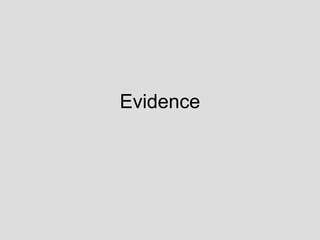
Evidence
- 1. Evidence
- 2. What is evidence? • In the law evidence can be broken down into two categories… – Direct evidence – Physical evidence
- 3. Direct evidence • Direct evidence is made in the form of a statement made under oath, such as a witness pointing out a person that they believe committed a crime • We also call this testimonial evidence
- 4. Physical evidence • Physical evidence is any object or material that is relevant to a crime including small and large tangible objects, and/or smells and odors. • This evidence is collected by the CSI then processed by a lab technician
- 5. Why is it important? • Physical evidence can… – Prove a crime has been committed – Corroborate testimony – Link a suspect with a victim or crime scene – Establish the identity of associated persons – Allow reconstruction of events at a crime
- 6. • Evidence can also be broken down more by how much “weight” it carries in court proceedings.
- 7. Indirect evidence • Indirect evidence is evidence that does not prove a fact; it only establishes a hypothesis based on facts…most evidence falls into this category
- 8. Circumstantial evidence • Circumstantial evidence implies a fact or event…such as possession of narcotics • The greater the volume/amount of circumstantial evidence there is the more likely it is that it is factual (probability and statistics.
- 9. What is good evidence? • The rules of evidence define what evidence is admissible and what evidence is not
- 10. • Material evidence is all evidence that is relevant to a particular crime • Evidence that proves something in a case is what we call probative. • You want to convict someone then you better have material evidence that is probative
- 11. Inadmissible evidence • Hearsay is a form of evidence that is not permissible in court because the person was not under oath when the statement was made
- 12. Credibility • The expert witness is the person that is the expert in the field of science…they are the presenter of information in court • Credibility is established through credentials, background, and experience in the topic.
- 13. What makes it admissible? • There are two court rulings that have largely governed the admissibility of evidence in court – Frye vs. the United States – Daubert vs. Merrell Dow Pharmaceutical, Inc.
- 14. The Frye Standard • The Frye standard states that in order to be probative – Testimony must be given by an expert witness – The techniques used must have gained general acceptance within its own field
- 15. The Daubert Ruling • The Daubert ruling stated that the Frye standard was not an absolute prerequisite for admissibility in court, and that it was the judge that was responsible for determining validity • The Frye standard was to be used only as a guideline
- 16. Why did it change? • The Daubert ruling changed the previous Frye standard to help keep up with technological advances in the field. • The guideline is: – The technique or theory must be testable – The theory must be subject to peer review – Potential error, and rate of error must be stated – The techniques must follow a standard – Consideration of the widespread acceptance, or lack of, within the scientific community must be taken